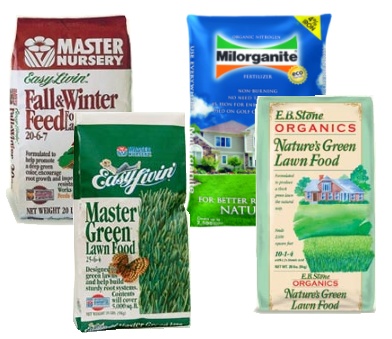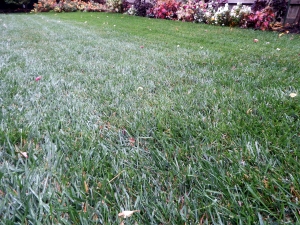Lawn Care & Maintenance Guide
A healthy lawn can add beauty and be a functional part of your landscape. Lawns can provide a relaxing space to play and entertain. Besides lawns being attractive and adding value to your home, they also help the environment by filtering dust and pollutants, cooling down the area around them during the summer months, and providing oxygen to us. Below are a few tips that can help you maintain a beautiful lawn with minimal work and time.
Watering your Lawn
How often to water is a question
that is often asked. The answer depends on several factors including soil type,
outside temperature, wind, type of grass, and how you maintain your lawn.
During the winter months, you may not need to water at all as long as it rains
every couple of weeks. In the Spring, you may need to water once or twice a
week depending on the temperature and Spring rains. In the Summer and early
Fall, generally twice a week should be sufficient with an occasional extra
watering during very hot periods. If you have a timer, it is important that you
understand how it works so you can make adjustments to your watering schedule
as the seasons change.
Watering deeply and less frequently will make your
lawns less susceptible to changes in the weather and will encourage the roots
of your lawn to go deeper into the soil. It is important to understand that
deep watering is more important than frequent watering for short periods of
time. If you tend to water often, we recommend eliminating one or two days out
of your watering cycle and slightly increase the length of time of the
remaining watering cycles. For example, if you typically water your lawn for 10
minutes a day during the summer( a total of 70 minutes a week), we would
recommend reducing the days to 3 days a week for 15 minutes (a total of 45
minutes per week), and then after a few weeks, reducing the number of days to 2
days a week for 20 minutes (a total of 40 minutes per week). This is just an
example and the actual times may vary depending on the type of sprinklers you
have in your lawn and the amount of outflow from those sprinklers. The goal is
to find the balance between watering as little as possible while maintaining a
green lawn. Sometimes a little experimenting is required until you find that
balance.

Fertilizing Schedule
The purpose of fertilizing is to maintain a green, healthy lawn. This can be achieved by fertilizing at a minimum of 3 times per year, once in the Spring, once in the early Summer, and once in the fall. Two additional applications of fertilizer may be desired to provide optimum health. Depending on the time of year, different types of fertilizers are recommended for optimum growth and health. Below is a chart of when you might consider fertilizing and some of the options that you might consider to keep your lawn happy and healthy. Remember to water after applying fertilizers unless applying on a rainy day.
| When to Fertilize | Type of Fertilizer | Benefits |
|---|---|---|
| Late January to mid February | Master Nursery Fall & Winter Feed | Formulated for cool weather and provides nutrients needed for a green healthy lawn |
| Weed Prevention Option | *Bonide Crabgrass & Weed Preventer for Lawns | Greatly reduces the recurrence of annual bluegrass(poa annua) and crabgrass |
| Organic Alternative | E.B. Stone Nature's Green Lawn Food | A natural blend of feather meal, blood meal, bone meal, sulfate of potash, and humic acids. |
| Late March to early April | Master Green Lawn Food | Formulated for warm weather conditions and provides a good balance of nitrogren, phosphorus, and potassium. |
| Organic Alternative | E.B. Stone Nature's Green Lawn Food | A natural blend of feather meal, blood meal, bone meal, sulfate of potash, and humic acids. |
| Late May to early June | Master Green Lawn Food | This application will help carry the lawn through the summer months. |
| Organic Alternative | E.B. Stone Nature's Green Lawn Food | Nice slow release fertilizer that won't burn lawn in the summer heat |
| September | Master Green Lawn Food | Last application of the Master Green for the season |
| Weed Prevention Option | *Bonide Crabgrass & Weed Preventer for Lawns | 2nd application for the season to prevent weed seed from sprouting in the fall. |
| Organic Alternative | E.B. Stone Nature's Green Lawn Food | A natural blend of feather meal, blood meal, bone meal, sulfate of potash, and humic acids. |
| November | Master Nursery Fall & Winter Feed | Cool weather fertilizer that will give the lawn a boost as it heads into the winter months |
| Organic Alternative | E.B. Stone Nature's Green Lawn Food | A natural blend of feather meal, blood meal, bone meal, sulfate of potash, and humic acids. |
Mowing
Lawns look best and stay healthiest if mowed on a regular basis. The duration between mowings will depend on time of year and growth rate of your lawn due to fertilizing and watering. Generally, it is better to raise your lawn mower settings one or two notches during the summer months to help retain moisture better in the lawn. In the winter months, it is a good idea to lower the mower one or two settings to keep the lawn from getting fungi due to the colder and wetter days. In the winter, you may not have to mow for a month or more because grass generally grows slower during the cooler months. In the summer, you may need to mow weekly. If you have dwarf fescues, mowing may only need to happen every 10 to 14 days in the summer.
Insect Considerations
If your lawn starts turning brown in patches or not looking as green as you think it should, your lawn may be under attack by insects that often attack the grass at the root. If this is the case, you will want to inspect your lawn for grubs, cutworms, or other critters that might be doing damage. Most of the damage seems to be in the late Spring and early Summer and then again in the Fall. If you are having issues with these insects, you can apply Bonide Eight® granules to your lawn. We recommend applying Eight® in late May and then again in September. Additional applications may be necessary if you have a severe infestation of insects.
